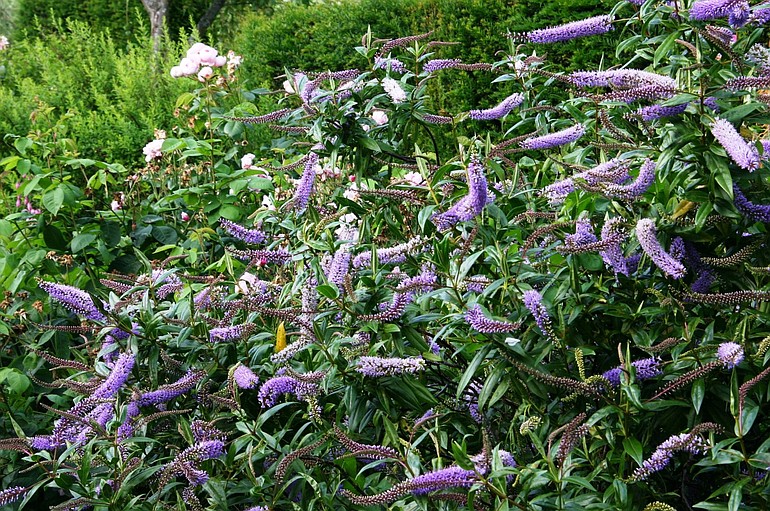I am always amazed at the incredible variety of shrubs on show in the typical Northwest neighborhood. Although I know a few gardeners who would like to try, none of us can plant every shrub available. We each have to choose a unique assortment of plants to fit our personal tastes as well as the size of our gardens and our budgets. The pleasant result of all this is a bounty of shrubs on display throughout many different neighborhoods.
As interest in garden design becomes more sophisticated, we discover that a shrub is much more than a plant to wrap around the base of a house’s foundation. Placed in beds and mixed into borders, shrubs relate the house to the garden and people to the house. As I see it, shrubs are the horizon of the garden. At eye level, on a human scale, the shrubs surround, divide, and enclose the spaces in which we live. Rising above the shrubbery are the rooftops of our houses, the trees and the sky. Below are the masses of ground covers, from grass lawns to beds and borders planted with brightly colored annuals and perennials.
Pay attention to the most beautiful gardens in your own neighborhood and you will see that shrubs carry the garden seamlessly through the year. Regardless of the season, they contour and outline garden spaces and give a sense of privacy and enclosure. Many shrubs use the color of their flowers or foliage to tie the picture together. A hot red rhododendron looks great against a yellow house wall. The clear, salmon-pink blossoms of the flowering quince, Chaenomeles x superba “Cameo,” add an elegant contrast to a stone wall.
Used individually, shrubs can stand as specimen plants for each season. Winter blooming shrubs herald spring. The Sasanqua camellia “Yuletide,” with its Christmas red flower petals, yellow anthers and deep glossy green leaves will bloom from November through January. Its flowers hold on into early spring after a mild winter. Spring blooming shrubs add color, height and texture to a flower border. Roses and hydrangeas continue the show through summer. The fiery autumn leaves of the compact Burning Bush (Euonymus alata) rival any seasonal flower display.
Used in groups, shrubs frame a view, divide a garden or serve as a backdrop for the flower display in a perennial border. Shrubs can be useful in dividing a garden into specific areas or rooms as well as screening the garden from neighbors, from an unsightly view or (heaven forbid) from a neighbor’s unsightly garden. Like a backbone, landscape shrubs add stature and hold the garden in alignment.
For the most visually appealing garden, it is best to use a mix of evergreen and deciduous shrubs. The evergreen shrubs establish a framework and are a visual constant throughout the year. Try two boxwood, trimmed to stand as sentries at the entrance of a formal garden. Even a small garden benefits from a mass planting, as long as it is kept to the scale of the garden. A cluster of three or more “Gold Beret” barberries (Berberis thunbergii) adds a mass of color to a forgotten corner of the garden.
Deciduous shrubs enliven the garden with their seasonal metamorphosis. While deciduous shrubs lose their foliage for the duration of winter, the reemergence of their leaves in spring adds instant color and interest to the garden. Choose shrubs for their growth habit, ornamental flowers and seed heads, along with leaf texture and bark display. Remember to plant a mix of trees, shrubs and perennials.
We use shrubs in our gardens to connect and complete the landscape picture. Keep the basic design within nature’s bounds, grouping shrubs in complimentary colors, shapes and size and always allow each plant enough room to mature to its full potential. This week, take some time to walk around your neighborhood and consider the possibilities of using shrubs in your own garden.
Consider introducing shrubs with scent into your garden living spaces. The viburnum “Korean Spice” (V. carlesii) has a heady scent that hangs like a cloud in the air of an enclosed garden. In late summer, the perfume of Clethra alnifolia, commonly known as Summersweet, attracts gardeners and hummingbirds alike. The heavenly scent of lilac is legendary. If left to go to seed, lilacs will attract an assortment of birds to the garden. The more I think about shrubs, the more I have to agree with the old adage, at least in our gardens, “You can never have too much of a good thing.”
Robb Rosser is a WSU-certified Master Gardener. Reach him at Write2Robb@aol.com.



